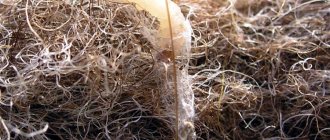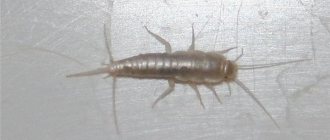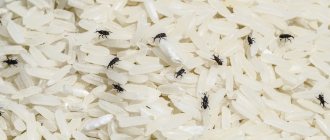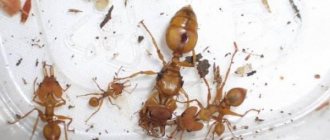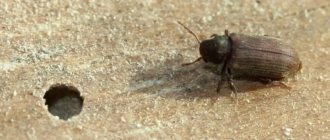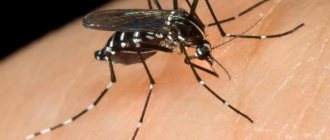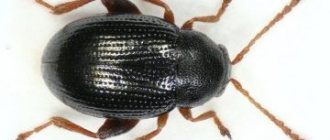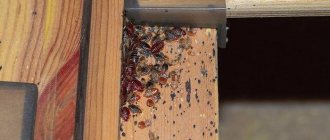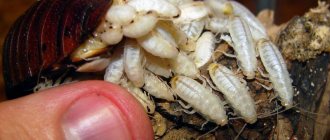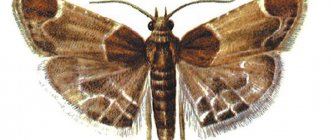Please note that cereal moths can settle in different nooks and crannies of your apartment, so don’t be lazy, go over all the furniture, lamps and cornices with a damp cloth. Lyudmila Nikolaevna encountered a problem at home and asks us a question: “There are worms in the cereals. How can you get rid of them, how did they get into stocks?”
We'll tell you how to deal with uninvited guests.
Worms are the growing offspring of the cereal moth.
Most likely, the “invaders” are entering your kitchen along with groceries brought from the store. Inspecting the purchased flour and cereals is your primary task.
Why did worms appear?
If the moth is not brought in from outside, figure out what reasons caused its appearance in your food supplies:
- Expired shelf life. Don't forget to look at the manufacturing date on the packs. Do not buy “tons” of cereal in anticipation of a hungry year. Throw away expired cereals without regret.
- Violated storage conditions. Do not create a tropical climate in the kitchen with high temperature, humidity and stuffiness: moths will perceive this as a signal to reproduce. Ventilate your galley more often, and send bulk provisions to the balcony in winter - for prevention.
- Wrong container. The ideal option is a glass container with a tight-fitting or airtight lid. The less air enters the jar, the longer the shelf life of the product.
If the larvae of the cereal moth have already penetrated your food, radical advisers demand... throw it away, since even by removing the living creatures, you are unlikely to clear your supplies of its microscopic excrement
Who are the bugs in the cereal?
Thrifty housewives are familiar with the situation when tiny bugs appear in food supplies (especially bulk products). It is unpleasant to discover such a find: adults and their larvae look disgusting. And, of course, the cereal in which the parasites have settled must be disposed of.
It is especially unpleasant if there is a lot of spoiled food. Small insects and other pests of grain products can destroy significant volumes of food supplies.
Kinds
Most often you can find the following pests in a bag of flour or a can of cereal:
- Flour beetle. This is a black or brown beetle, its body length varies from 3 mm to 1.5 cm. The insect larva (mealworm) is light yellow in color. The flour beetle lives in pantries and other places where stocks of flour, grain and bakery products are located. When multiplying en masse, the beetles spoil the flour, which becomes lumpy and acquires an unpleasant odor and taste.
- Weevil (rice, nut and granary). These are small brown insects with an elongated proboscis. Parasites prefer to eat buckwheat, rice, flour, pasta, as well as legumes and nuts.
- Bread (grain) grinder. This is a small brown bug that can fly. Most often, parasites live in factories and warehouses where bakery products are produced and stored. Such a bug is brought into the house along with food. The grinder, in addition to flour products, eats medicinal herbs, tea leaves, cereals and pet food.
- Suriname mucoed. Another lover of flour is a tiny (2 mm) red-brown bug native to Latin America. The flour eater is omnivorous: it likes cereals, dried fruits, and pasta. The pest lives and reproduces only in high humidity. Parasites enter a residential building with poorly dried food.
- Food moth. This is a small (about 1 cm) inconspicuous butterfly, which is highly fertile. In 1–2 weeks, the moth manages to lay about 500 eggs, from which caterpillar larvae emerge. It is the larvae that devour the reserves of cereals and grains. Moths are very difficult to remove because they hide and reproduce quickly.
Food (grain) moth: Wikimedia
How do bugs get into the house and what is their danger?
How do small pests grow in cereals and other products? Parasites enter pantries and warehouses in the following ways:
- From outside. Moths and other flying insects constantly migrate in search of better living conditions. Some bugs are attracted to light in the window. Having flown into the house, insects look for the food they need and settle in the cereals for a long time.
- Along with products. Adults and larvae are brought into the house along with food. If food storage rules were not followed in the warehouse, then bugs in flour or cereals are a common occurrence. The risk of bringing in uninvited guests increases when you buy bulk products by weight.
The bugs themselves do not pose a threat to human life, but their presence in cereals causes unpleasant emotions. Insects destroy and spoil food supplies in the house. Waste products of parasites remaining in supplies and entering the human body along with food can cause gastrointestinal upset and an allergic reaction.
Tips from experienced housewives
The centuries-old fight against kitchen “evil spirits” has enriched folk experience with several effective recipes to block the path of voracious parasites:
- you need to put an aluminum spoon or a piece of foil into the flour and cereal;
- use fabric bags for bulk provisions, previously soaked in a strong solution of table salt;
- some housewives are sure that any metal storage container is an excellent preventive measure against worms;
- Many people recommend adding cloves of garlic to cereals.
Most likely, the “invaders” are entering your kitchen along with groceries brought from the store. Inspecting purchased flour and cereals is your primary task.
Methods of combating the parasite
Small bugs in flour, cereals and other dry foods lead to many problems. The peak of their activity is observed in the summer season. When foreign dark inclusions are found in flour, cereals and the like, it is actually possible to say with complete confidence that these are flour eaters. Their detection indicates the need for a serious revision of stocks - this is the main stage of any technique that allows you to remove parasites. Without this step, none of the methods to completely get rid of mucous will give the expected results.
Attention! A period of activity and a rapid increase in the number of mucoed individuals can also occur in winter - when the temperature in a residential building or apartment is high.
The beginning of the fight against such pests is marked by the need to carry out a thorough cleaning of not only the kitchen, but also all other rooms in the apartment or house. At the same time, any products and other objects suitable for the parasite to live in (acorns, untreated wooden blocks, etc.), if the presence of a mucous beetle is suspected, must be thrown away. In the future, after getting rid of the parasite, to prevent it from returning, you need to perform regular cleaning and follow the rules for storing cereals.
Getting rid of bugs and worms
- If the larvae of cereal moths have already penetrated into your food, radical advisers demand... to throw it away, since even by removing the living creatures, you are unlikely to clear your supplies of their microscopic excrement.
- If you feel bad about throwing it away, you can try calcining it and sifting it. Pass semolina and flour through a sieve. Cereals with more tangible grains should be placed in an oven heated to 120 degrees for a quarter of an hour. After the cereal has cooled, it is sifted through a colander with fine holes. Such measures will also allow you to get rid of flour moths, which prefer to lay their larvae in flour.
- Fundamental “disinfection” also includes the treatment of furniture: cabinets must be thoroughly scrubbed with vinegar (outside and inside). Wash the backs of wall cabinets and all kitchen utensils and dishes.
- Throw away old plastic and paper bags that provide both food and shelter for kitchen pests.
- Keep in mind that grain moths can settle in different nooks and crannies of your apartment, so don’t be lazy, go over all the furniture, lamps and cornices with a damp cloth.
- You are given one day for general cleaning - during this time the insects will not be able to gain a foothold in the new bridgehead.
From now on, maintain exemplary order in the kitchen, regularly getting rid of trash and not forgetting to “audit” your storage areas.
Human interaction
Often used for biological research. Its relatively large size, ease of propagation and handling, and status as a non-model organism have made it suitable for proof-of-concept studies in the fields of basic biology, biochemistry, evolution, immunology, and physiology.
Like a pest
Flour beetles are generally considered pests because the larvae feed on stored grain. Probably originated in the Mediterranean region, but are now present in many regions of the planet as a result of human trade and colonization. The oldest archaeological finds of Khrushchak can be traced back to the Bronze Age of Turkey. Finds from the British Isles and northern Europe date back to a later period, and archaeological finds from Ancient Egypt do not contain Khrushchaki.
Like food
Mealworms are commonly used as food for reptiles, fish and birds. They are given to wild birds in feeders, especially during the nesting period. Beneficial due to high protein content. Used as fishing bait.
Doll
Sold in bulk, usually packaged in bran or oatmeal food containers. In commercial breeding, juvenile hormone is added to the feed to ensure that mealworms remain in the larval stage and reach an abnormal length of 2 cm or more.
Larva
As food: entomophagy
Mealworms are edible for humans and are processed into several food products available at retail, such as hamburgers.
Burger with mealworms as the main ingredient
Historically used in many Asian countries, especially Southeast Asia. Commonly found in food markets and sold as street food along with other edible insects. Baked or fried mealworms have been sold as a healthy snack in the recent past, although their use dates back centuries. They can be easily grown on fresh oats, wheat bran or grain with chopped potatoes, carrots or apples as a water source. The small space required for breeding has made mealworms popular in many areas of Southeast Asia.
Mealworms in a bowl
Were included in new tequila-flavored candies. They are not traditionally served in tequila, and the "tequila worm" in some mezcals is usually the larva of the Hypopta agavis moth.
On the market in Germany
The larvae contain a significant amount of nutrients. For every 100g of raw mealworm larvae there are 206 calories and 14-25g of protein. They contain such a percentage of potassium, copper, sodium, selenium, iron and zinc that they compete with beef. Also contain essential linoleic acids. They contain more vitamins by weight compared to beef, excluding B12.
Freeze-dried mealworms as food
In the field of waste management
In 2015, it was discovered that mealworms can break down polystyrene into usable organic matter at a rate of about 34–39 milligrams per day. In addition, during the month-long experiment, no differences were found between mealworms fed only polystyrene foam and those fed regular food.
A newly hatched beetle, its exuvium and prepupa
Microorganisms in the intestines of the mealworm are responsible for the destruction of polystyrene, and larvae receiving the antibiotic gentamicin show no signs of decomposition. However, isolated colonies of mealworm gut microbes were found to be less efficient at decomposition than bacteria in the gut. There were no attempts to commercialize this discovery.
On wheat
Preventive actions
Many housewives have experienced from their own experience that getting rid of harmful insects in cereals can be quite difficult, no matter what the scale of this disaster. In order to prevent harmful bugs from entering your home, it is advisable to carefully consider the organization of preventive measures.
- Flour eaters cannot tolerate sunlight, so it is advisable to place transparent, tightly closed containers with cereals on shelves that are not closed with doors.
- After the products have appeared in the apartment, it is advisable to make sure that they are dry enough before storing them.
- You can prevent insects from infesting cereals by placing dry, clean steel nails in the containers. These can also be aluminum spoons that have been kept at home for a long time.
- Bugs cannot tolerate aromas coming from bay leaves or garlic. They can be placed on top of the container, and the garlic clove is first peeled.
- Scents are also placed on the shelves - cloves, bay leaves, garlic, dried lavender flowers.
- To prevent Indian moths from getting into your cupboards at home, you need to make it a rule to regularly take out supplies of cereals, flour, tea, dried fruits, pasta, ventilate them and simultaneously wipe all surfaces of the cabinet with a weak vinegar composition.
- To prevent Indian moth larvae, the upper edges of the containers containing the cereals should be lubricated with vegetable oil. White worms cannot get inside through such an obstacle.
It’s a good idea to allocate a separate wall cabinet for the quarantine area, where newly purchased bags of cereal or flour are placed. You can place them in the refrigerator in the freezer compartment for several hours. You should not make bulky supplies; it is better to purchase certain types of cereals and pasta as needed.
Prevention: how to avoid infection
To protect your own products from infection by pests after disinfestation, you can take some safety measures. To do this, a number of preventive measures are used, the main one of which is being careful when buying cereals and flour in a store or at the market. At home, you also need to consider a number of rules that can protect products:
- for bulk products you need containers with tight lids;
- You can place garlic or bay leaves on the shelves;
- when wet cleaning, vinegar or ammonia is added to the water;
- regular ventilation will reduce humidity in the room;
- Large reserves of cereals, flour and pasta cannot be made.
The main problem of mucoeds living in industrial warehouses, bakeries, shops, apartments and private houses is the destruction of food supplies in a short period of time. Because of this harmful insect, in a week or a month the entire available supply of flour, cereals and other groceries in the kitchen or pantry can be destroyed, and prevention is the best method of protection.
Attention! The main product in which the flour eater starts is flour. It is better to store such supplies separately from other bulk materials, which will reduce the likelihood of the spread of insects.
How to prevent uninvited “guests” from multiplying
Even if the parasites thrown out along with the cereals never return to the kitchen, some of the insects, having spread throughout the house, will continue to reproduce successfully. To completely eliminate pests, you need to act in three stages.
Inspection of stocks and sending to quarantine
Carefully check all food stored in the house for the presence of voracious insects. Throw away all supplies containing pests. Place cereals in which no traces of pests were found in the freezer for three to four days. After this period, you should carefully sort through the bulk products: if the bugs do not appear, they can be placed in jars for storage.
Washing containers
If cereals attacked by insects were stored in plastic or glass containers, the containers can be disinfected. At home, this can be done like this: soak for half an hour or longer in a strong soap solution, then rinse with running water and dry. It is best to replace the storage jars with new ones, after washing them with soda or laundry soap.
spring-cleaning
You can treat the cabinets to get rid of bugs in the cereal with a strong solution of laundry soap and soda. It wouldn’t hurt to wipe down the shelves, tables, window sills, floors, even the walls in the kitchen. After this, walk over the surfaces with a cloth moistened with a 9% vinegar solution (a tablespoon per liter of water). Pour boiling water over latches in cabinets, cracks in floors and walls.
It is advisable to clean the cabinets with a vacuum cleaner using a narrow attachment: this measure will help get rid of eggs, larvae and pest excrement. Particular attention should be paid to corners, cracks and doors.
Method of getting rid of mucoed
The Suriname mucoed, despite its name, happily consumes supplies of cookies, cereals or dried fruits. He cannot eat dry grain, so he is an infrequent guest in the apartment. Females hide eggs in cracks inside the closet and folds of packages, so it is almost impossible to see them. It is usually the already fully formed brown adult individuals that give themselves away.
As soon as it becomes clear that flour eaters have appeared at home, you need to try to get rid of them immediately so as not to lose valuable food supplies. All internal surfaces of the cabinets are thoroughly washed with soapy water, rinsing with clean water at the last stage. Existing cracks, as well as shelf joints, are treated with table vinegar. At the same time, measures are being taken to eliminate pests in stocks.
You can get rid of larvae and adult insects suddenly found at home by heating the surviving cereal in the oven at a low temperature (≈ 50°C). Pasta and flour can also be heat disinfected. The flour is pre-sifted. It is useful to keep the cereal in the freezer for 24 hours before heating it to be sure to get rid of any undetected eggs.
Before carrying out such a procedure, it is advisable to go through all containers, identifying damaged specimens. There is no point in reviving heavily contaminated cereal stocks, since they are no longer suitable for human consumption and will have to be destroyed. If possible, you can cook porridge from them for livestock or feed them to birds.
Flour beetles are a serious danger
Adult mealworms are small (up to 4 mm long) red-brown beetles with glossy surfaces. They often appear in the apartment with contaminated flour or in starch packets. For these insects, paper or cellophane bags and loosely closed containers are not an obstacle.
Favorite habitat is flour and some types of cereals - wheat, rolled oats, semolina. To understand the damage that beetles can cause, it is enough to know that each female lays almost 1000 eggs. Given the enormous speed of spread, it is necessary to make a decision on how to effectively get rid of the pest very quickly, since it will be necessary to destroy all stocks where the beetles have managed to appear in large quantities.
After inspecting and separating the containers with cereal, which upon visual inspection seemed undamaged, it is necessary to place them in the freezer compartment of the refrigerator for 24 hours. This procedure is quite effective, since beetles at any stage of development die at low temperatures.
In this way, it will be possible to get rid of eggs or larvae, which may be found in cereals in small quantities. Legumes can be placed in a saline solution, the water containing any insects that have floated to the surface can be drained, washed and thoroughly dried at home.
All cabinets are treated in the same way as when fighting mucoed. You can sprinkle powdered pyrethrum, a herbal remedy based on Caucasian chamomile, on the shelves, which is destructive for worms, by purchasing it at the pharmacy. The procedure is repeated after a week and a half. Small paper bags with an open top are laid out in the apartment as bait for insects. A mixture of semolina, powdered sugar and borax, taken in equal quantities, is poured into them. Although this composition is harmless to humans, the bait should be inaccessible to children.
Worms in flour: harm to humans from parasites
Quite often, many housewives encounter various problems in the form of parasites in their kitchens. This is especially true for cereals and flour, where peculiar white or yellowish worms are found.
These parasites are capable of attacking anyone and it is quite difficult to insure against them, since any products become potential foci of localization and can be harmful to humans.
Some housewives, seeing a mealworm, associate it with parasites such as roundworms and other helminths. In fact, these pests cannot harm a person in the form of damage to health.
In addition, mealworms are excellent food for various poultry, and many people even raise them in specially created conditions.
If these parasites have entered the kitchen without permission, then there is nothing left to do but begin to wage a merciless fight against them, and fortunately, there are plenty of ways to do this.
